
SUNDAY, JAN 8, 2023: NOTE TO FILE

Gaia Education
A short 8-week course in ecological design
Eric Lee, A-SOCIATED PRESS
TOPICS: SUSTAINABILITY, FROM THE WIRES, LANGUAGE GAMES
Abstract: As I have sustainability concerns and concerns for posterity's and the biosphere's future, I will start a course in Ecological Design tomorrow, which is one of four 'dimensions' of the offering. Subnotes to file will likely follow.
COOS BAY (A-P) — As homework (I'm an autodidact, so I assign myself homework), I found a video introduction to Gaia Education and turned Google's auto-transcript into a readable one for those who can read faster than narrators speak. As an autodidact, I've had an interest in sustainability studies for 8 years, but have no formal education in any relavant field included within 'sustainability studies', e.g. neo-classical economics or permaculture. For extra credit, I will submit this webpage for consideration after I've had enough education (schooling).
I have no specialty, but I am a generalist who doesn't know enough about anything to serve the monetary culture, i.e. the modern techno-industrial (MTI) form of civilization, aka the World Socioeconomic-political System (WSS). The other three dimensions are also 8-week courses. The course descriptions follow the transcript and include questions I will be able to answer after taking each course.
To compare with what my answers might be after taking one or more course, I answered all the questions to see how I might update them after the course. The four courses are sort of the undergraduate level 24 hour part leading to taking the 23 hour Design Studio course as a graduate school offering where you join teams to design putative solutions to humanity's problems.
Gaia Education (currently 25k interconnected people)
7 minute intro video from 2010 with 12k views.
We believe that the most promising and effective way to deal with all the crises our generation is facing is through education. Not a traditional education, but a new kind of global education specifically designed to meet the challenges and opportunities of the 21st century.
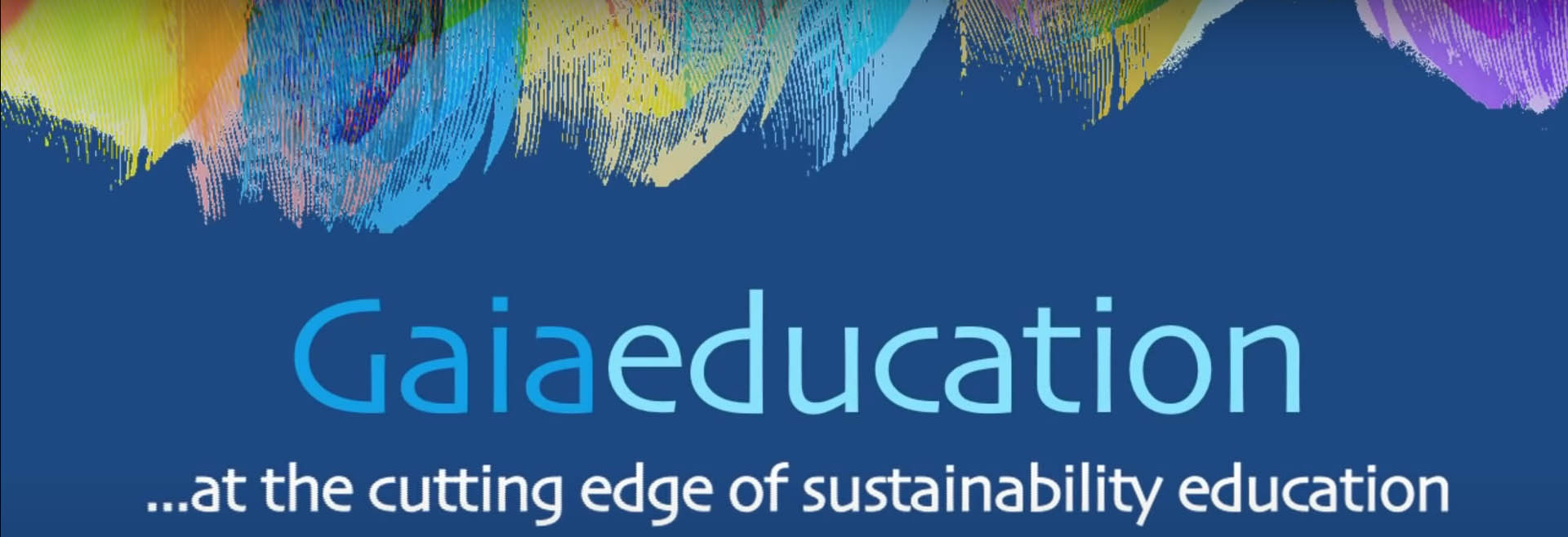
An education that is universal in scope, but local and application relevant to people of both industrialized and non industrialized countries in both rural and urban regions.
An education that empowers individuals and communities with the knowledge for shaping their worlds and becoming more self-reliant. An education that marries the academic and the experiential, providing students with the opportunity to combine intellectual exploration and personal development with hands-on projects. An education based on living systems and the interdependence that we need to make the transition to a sustainable culture.
In 2005, a group of experienced ecovillage educators in a wide range of disciplines from academic and professional backgrounds founded Gaia Education.
We call ourselves East Global Ecovillage Educators for Sustainable Earth to acknowledge the collaboration roving leadership that happens when the geese fly information.
Gaia education promotes a holistic approach to an education for sustainable development by developing curricula for sustainable community design. While drawing upon best practices within ecovillages worldwide high education also works in partnership with universities, governments, non-government agencies and the United Nations.
The major achievement of Gaia Education to date has been the development of the groundbreaking ecovillage design curriculum which draws from the experience and expertise of a network of some of the most successful ecovillages and community-based projects around the world.
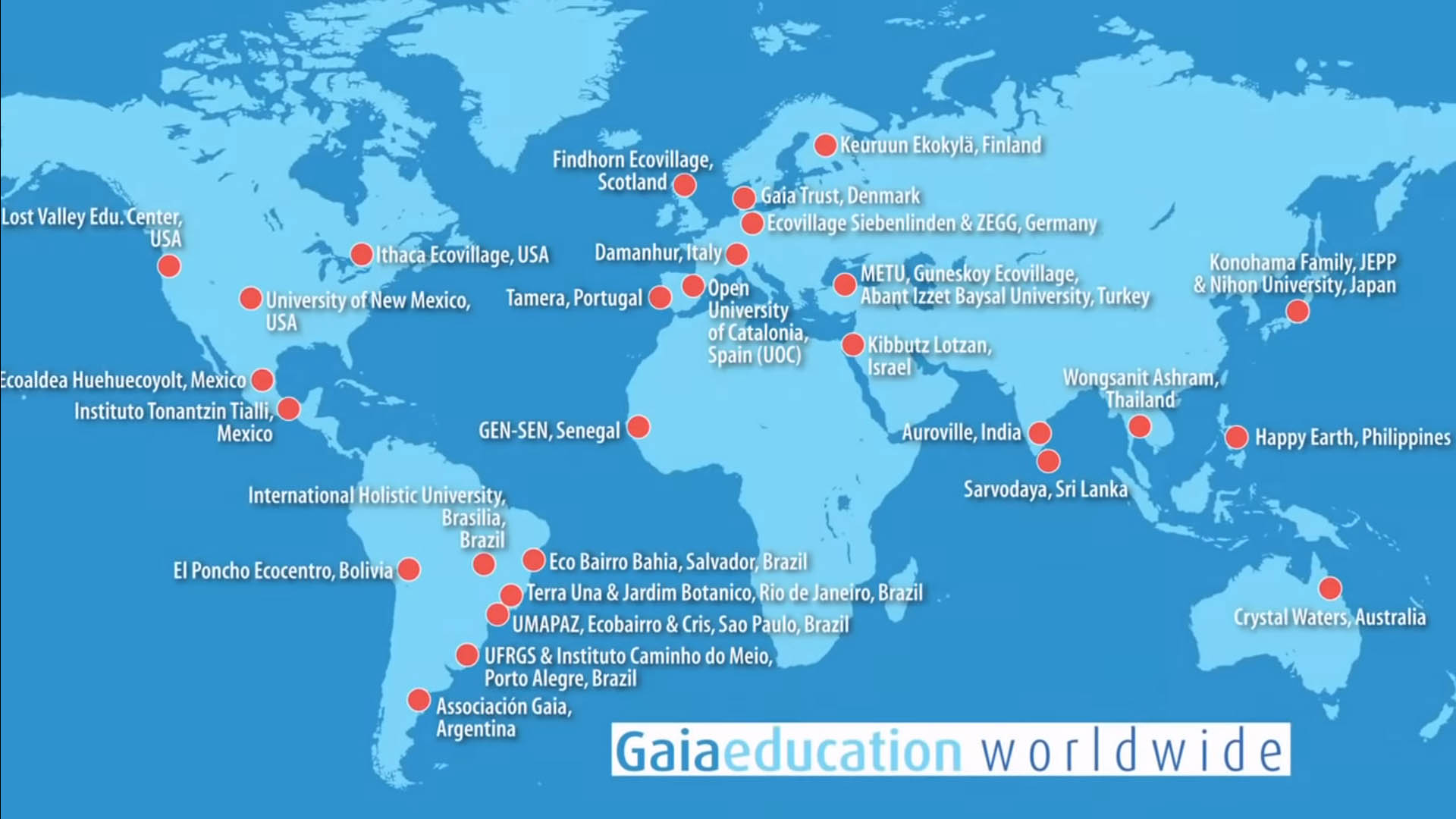
The ecovillage design education curriculum focuses on fundamental principles, themes and aspects of sustainability design and development in general. It is systemically organized as a mandala of what is perceived to be the four primary dimensions of human experience: ecological, social, economic, and worldview.
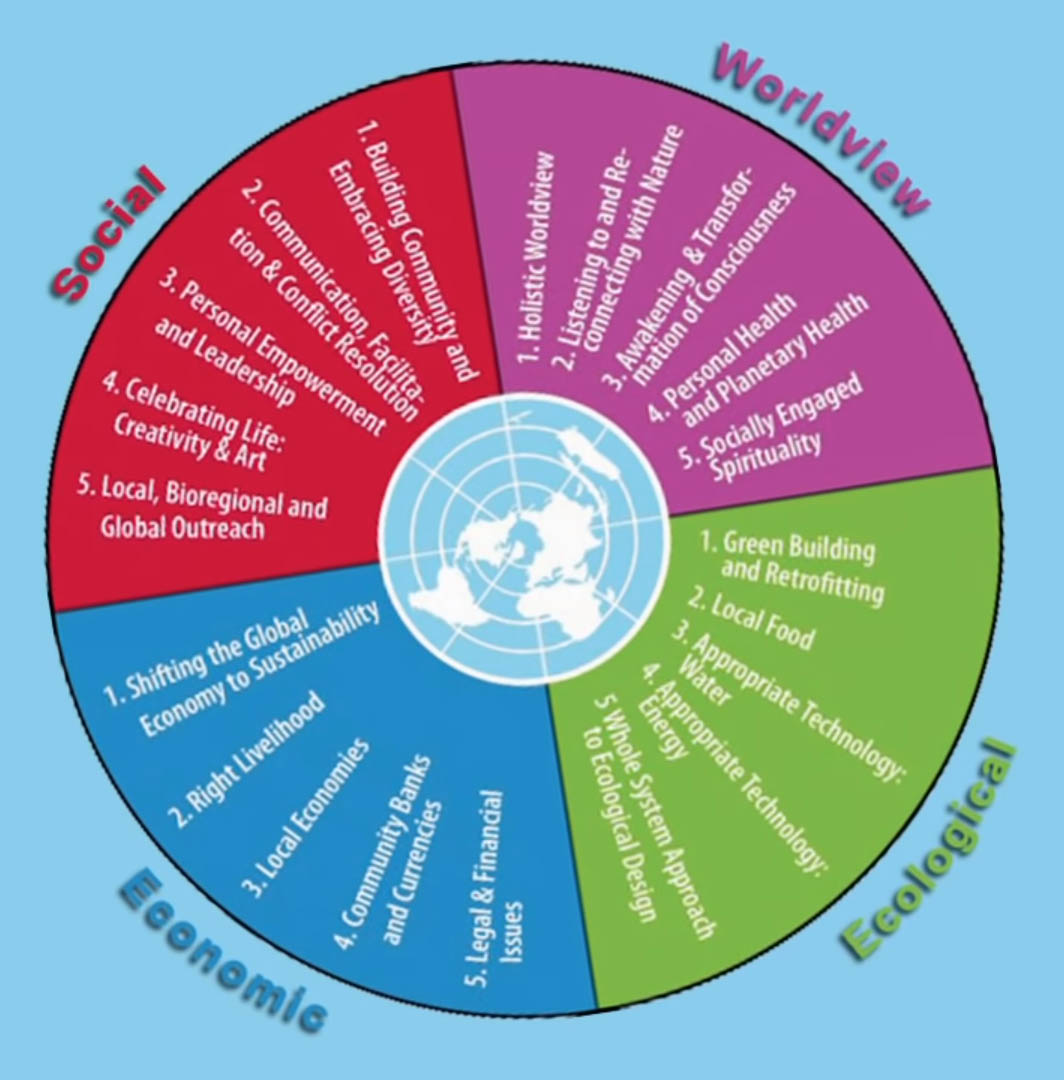
Within the ecovillage design curriculum, each of these four dimensions in turn contains five modules. The EDE provides an education where a thorough and objective assessment of the state of the planet is followed by place-based solutions.
Ecovillages are laboratories for sustainability. As such they provide excellent classrooms of innovative life skills for EDE participants.
Gaia Education was born out of the ecovillage movement and in a short period of time it spread its wings. Today it teaches in various settings and in partnership with universities and many urban centers.
The urban courses, such as that pioneered in San Paulo, are spreading fast. A growing number of towns and cities are now hosting Gaia Education courses.
One of our international partner academic institutions may be offering a Gaia Education accredited course near you. In addition to being closer to where you live, some of these courses also allow you to work while you are learning, such as the virtual Gaia Education Design for Sustainability or GEDS. Offered in partnership with the renowned Open University of Catalonia in Barcelona. This nine-month online program can be followed in Spanish or English.
It is very much suited to people who live in remote areas and working people who can study in evenings and weekends.
GEDS will become a postgraduate course in 2011. As a first step to convert the program into a master's degree. Another key partner of Gaia Education is the innovative educational program Living Roots which works in partnership with the University of Massachusetts and offers accredited ecovillage based semesters on five continents.
Some of these collaborative courses are located within traditional villages in the Global South where indigenous values and practices join forces with modern sustainability approaches.
The EDE has been recognized as an official contribution to the United Nations Decade of Education for sustainable development 2005 to 14. It is available in English, Spanish, Portuguese, Finnish, German, and Japanese.
It has been taught in 21 countries on five continents where more than 1,100 people have been trained over the last three years.
Our programs are of relevance to people of the most different backgrounds. Students and educators interested in sustainability design, NGO members, as well as ethical business leaders, professionals from engineering, architecture and renewable energies, to community builders and leaders everywhere. In short our programs are for all those who are concerned with the future of the planet.
Gaia Education's aim is to create a generation of leaders who can help facilitate the transition to a holistic sustainable culture. Its contribution is the gift of educational programs that help us understand the interconnected and interdependent nature of reality and how we can create a meaningful, dignified, and high-quality life for all the world's people.
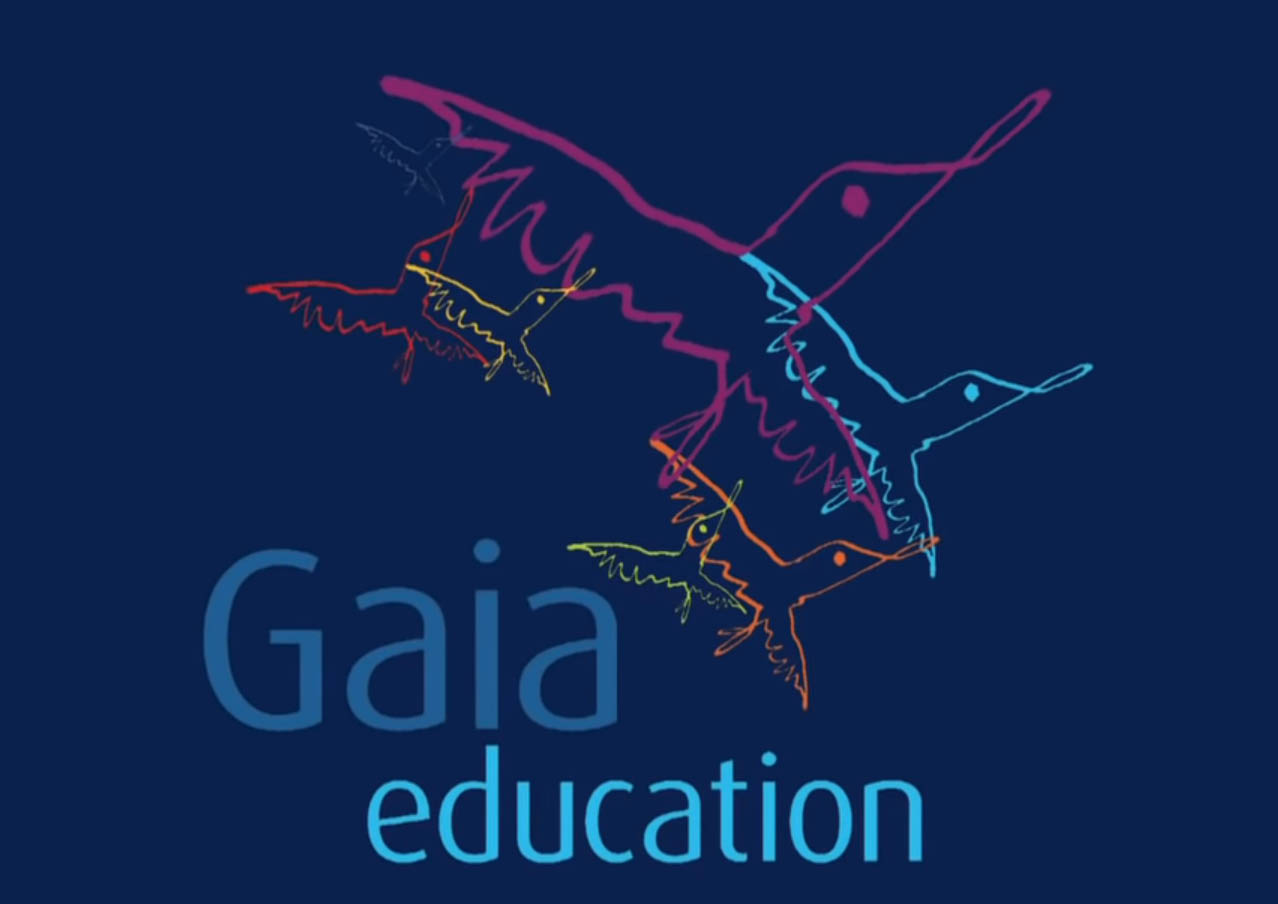
'...for all the world's people' are the last words. From posterity's POV, they may be viewed as 'famous last words', words that fail to grasp the challenge of avoiding a ghastly future, i.e. not good news for 10 year olds.
Course Descriptions
In the Social dimension we will address the following questions: [questions addressed]
- What is the vision that will support projects to be coherent and inspiring? [Alternative to the monetary culture's worldview is the matter-inergy-li systems worldview whose coherency is data based.]
- How will decisions be made and conflicts resolved? [Data supports or disconfirms claims, conjectures, to allow understanding to iterate towards coherence.]
- How will we walk that delicate line between being an individual and growing our personal empowerment, while being part of a collective endeavour? [Listen to Gaia who has all the answers by not listening to the subvocal voice in your head nor the primate prattle of others as there is no boundary out there between self and other. Maya is not out there.]
- How will we celebrate our diversity in a just and inclusive manner when we are challenged by our differences? [Guess then test to see what works as Gaia alone determines, selects for or not.]
- How do encourage equality, diversity and inclusion in the workplace? [Transition to a biophysical economy of enough in which there is no workplace nor concept of work.]
- What will we do to reconnect with the creative source in the web of life and bring a sense of beauty and artistic craftsmanship to everything we do? [By standing down from our hubris heights to know that we are animals, dysfunctional animals who may persist by renormalizing.]
- How will our group, organisation, project or community reach out to other local and bioregional communities, to build bridges and facilitate learning from each other and more effective collaboration towards shared goals? [Rendezvous in a central city for a time several times a year to exchange genes (exogamy) and memes (tell stories no one believes in).]
In the Ecological dimension you will address the following questions: [questions addressed]
-
Why is the current impact of humanity on the planet’s life support system degenerative and how can we change this through whole-systems design approaches? [Human enterprise, the modern monetary culture, is in overshoot. The condition that will come anyway is rapid contraction of the global economy and population whether by design or chaotic descent.]
-
How can we co-create elegant solutions carefully adapted to the biocultural uniqueness of place? [By agreeing to a social contract that limits community size to 50 humans and the number of communities within a management area to 50 settlements or bands of nomads seeking to renormalize expansionist modern techno-industrialized humans as adaptive K-strategists.]
-
What is the wide range of water collection, management and ecological treatment technologies that can support us in the design of watershed stewardship systems? [While I am familiar with Brad Lancaster's claims, toured his Tucson rainwater catchment showcase, and have taken classes offered by the Tucson Watershed Management Group and read numerous back issues of their newsletter, I have not observed any 'turning scarcity into abundance', so I focus on living within viable limits, e.g. by ending all groundwater pumping not powered by human power alone. The estimated agrarian population of the current Tucson Metro area (currently over 1 million population) was 2,000, which included several bands of Apache hunter-gatherers who preyed upon the settled communities. The river used to flow year around, but with 30' of cut down no longer does, nor can the floodplain be irrigated if it did, and maximum population supported by severely degraded land is less than 500, though no one currently living in the area would have the skills to live there.]
-
How can we use the best of permaculture systems, regenerative agriculture, agroforestry and ecosystems regeneration to co-create thriving regional food systems? [The San as nomadic foragers live in a thriving regional food system as adaptive and evolvable K-strategists, while all expansionist forms of humans do not, so we should first learn from them, then consider permaculture, regenerative, organic, agroforestry, swidden, three and four field systems and agroecosystems claims experimentally to assess what works and why it works with a focus on energy inputs and outputs with results that can scale up.]
-
Which clean renewable energy sources, energy efficiency and transport technologies can help us to create zero-carbon solutions while increasing community resilience and strengthening regional economies? [Transition to a nomadic forager biophysical economy with nomadic groups or settled agrarians managing an agroecosystem limited to one fifth of the ecoregion occupied by up to 50 settlements to leave room for Nature whose 4/5th is unoccupied and unused by humans or their livestock, e.g. no grazing, no hunting, no gathering, no removal of matter/energy, so renewable energy sources include food and biomass (e.g. wood) produced well within the carrying capacity of the human's 1/5th where soil building practices sequester carbon.]
-
What range of ecological architecture, sustainable building materials and methods are appropriate for which kind of local conditions? How can they support regenerative development at the local and regional scale? [Building materials include snow/ice blocks, thatched huts, wikiups, teepees, tents, yurts, stone, brick, log, bamboo, sod, adobe, geltaftan, rammed-earth, straw-bale, wattle and daub, red cedar split-plank homes, skin covered brush, underground excavated space or caves, bark/split-wood shingles, re-purposed tires, pit houses, etc., varying by region.]
After completing the Worldview dimension, students will be able to: [implied questions addressed]
- Summarise the main characteristics of the dominant worldview and explain how its spread was closely linked to the development of Western science which focuses on mechanistic, quantifiable, measurable and predictable aspects of living systems. [What is the dominant worldview? Expansionist culture views Earth as an illimitable plane for the taking, hence faced with shortage, we seek to expand, go beyond the horizon to exploit new resources on this our planet for the taking.]
- Explain how over the last century, first physics, then chaos and complexity theory, and more recently earth systems science and biology, have revealed a fundamentally unpredictable complex reality in which we participate and intervene perpetually. [How does a systems view differ from the dominant worldview? The applicable understanding directly relevant to human persistence on Earth that could assist modern expansionist humans to renormalize would be systems ecology or ecolacy, Garrett Hardin's third pillar of the educated mind and the only essential pillar, the one lacking within the modern techno-industrial form of civilization.]
- Name a series of practices that have been used by effective change-agents to reconnect with the natural world. Something that has helped people to gain strength and insight like meditation, council, vision fasts and/or solo-time in nature. [Why has the pace of planetary destruction not slowed? Posterity faces a ghastly future and those who have incurred the debt they will pay deny that they are posterity's enemy, nor that they are the cause of the ninth mass extinction event that is poised to rival that of the Permian. Meditating on the human predicament and understanding ourselves could allow us hubris ones to stand down and degrow our population by rapid birth-off to avoid die-off (the ghastly future).]
- Structure an engagement process in a way that integrates multiple perspectives into a shared whole systems [How can modern techno-industrialized humans meta-reflexively escape from their Wittgensteinian fly bottle? To believe in growth, the expansionist form of human needed to transition to belief-based worldviews, to normalize belief in belief, now a cultural universal. Our belief in belief is the fly bottle, the meta-reflexive understanding of this condition is the ending of it, i.e. 'he who is sick-minded, but who knows he is sick-minded, is not truly sick-minded'.]
In the Economic dimension you will address the following questions: [questions addressed]
- What are the root causes and design faults of our current economic and monetary systems? [The 'wealth of nations' is based on energy and not money flows, i.e. Nature's laws of energetics; the economy is a subsystem of society and nature, neither of which are externalities; growth is the best thing ever but only for a time prior to collapse; for over 300 years Anthropocene enthusiasts have been incurring an overshoot debt they will not pay, but posterity will, hence modern techno-industrial society and its monetary culture is not remotely sustainable despite the exponential growth in the number of schools of sustainability since 2006.]
- How can we take local, regional and global action to shift the economy towards sustainability and regeneration? [Yes, by agreeing to a viable social contract that selects for a viable form of civilization based on a biophysical economy of enough.]
- What kind of complementary currency systems, community banks and local investment vehicles can help us to strengthen local and regional economies in global collaboration? [Global trade would be managed by the United Federation of Watersheds as global governance of watershed (not individual human) interactions based on environmental accounting (H.T. Odum] and eMdollar evaluation based on emergy (embodied energy) of trade goods and services. Any local, intra-watershed, currency would be per the design of the watershed which may exclude the use of any form of money, i.e. may specify a monetary prohibition.]
- Why is Gross Domestic Product an insufficient measure of wealth and wellbeing and what alternative indicators already exists? [Real wealth is measured as energy equivalents, i.e. solar emjoules. Using money/GDP obscurs what is happening, e.g. the belief that the economy is decoupling from nature is 'a mythic construct used to justify even further destructive growth'. Alternative indicators include the increasing rates of metal illness and social pathologies.]
- What methods and models are currently emerging in the field of new economics and the sharing economy to support collaborative consumption and peer-to-peer collaboration? [As conventional economics and most alternatives (e.g. circular, green-growth, degrowth, doughnut, post-growth, bioeconomy, sharing, gifting, ecological economic models) serve the current form of civilization, alternative would be biophysical eco-nomics whose methods and models apply to all species and is based solely on understanding energy and energy enabled material flows within complex systems, with the flow of money being an externality.]
- How can we learn from successful experiments to revitalise local economies and promote social innovation and entrepreneurship? [For over six million years our hominin ancestors lived within a viable form of civilization as adaptive and evolvable K-strategists, unlike the expansionist form of human over the last fifty thousand years, and as humanity's persistence implies renormalizing as K-strategists, we could learn from those who are normal humans (e.g. San, Hadza, and Pygmy) and from prior expansionists who have learned to renormalize, e.g. the Kogi.]
- What legal and financial considerations are important for the creation of successful regenerative enterprises and sustainable business models? [For over six million years the gifting economy worked. All other models are experimental and should be considered non-viable long term until proven otherwise as the millennia pass.]
Design Studio
The objective of the Design Studio is to practise the application of Gaia Education’s Design For Sustainability & Regenerative System principles. This is one of the best online courses out there where you will create an actual sustainable project plan in a group!
You will collaborate as part of a design team to develop skills in applying what you have learned to real-world design projects. The design project serves as an integrative exercise where participants explore the relationships between personal, social, ecological and economic sustainability. Design teams will be created around a number of design proposals at the beginning of the Design Studio. These may, but do not necessarily need to be, drawn from initiatives that participants are currently involved in.
-----------------------------------
[I have an ongoing design project for a viable transistional form of civilization. The goal would be to renormalize some modern techno-industrialized humans over an 8 to 20 generation period of transition to a viable enough form of civilization having a viable enough biophysical economy of enough to sustainabily support its population (estimated <35 million), viable as evidenced by its ability to persist as the centuries pass. Full renormalization, if possible, will likely take at least as long as the denormalization process, e.g. 60 generations on Malta. Hence the transition from the transitional form of civilization (CIV 4.x) to a viable form (CIV 5.x) will only be aparent some time after several millennia of sustainable living has passed.]
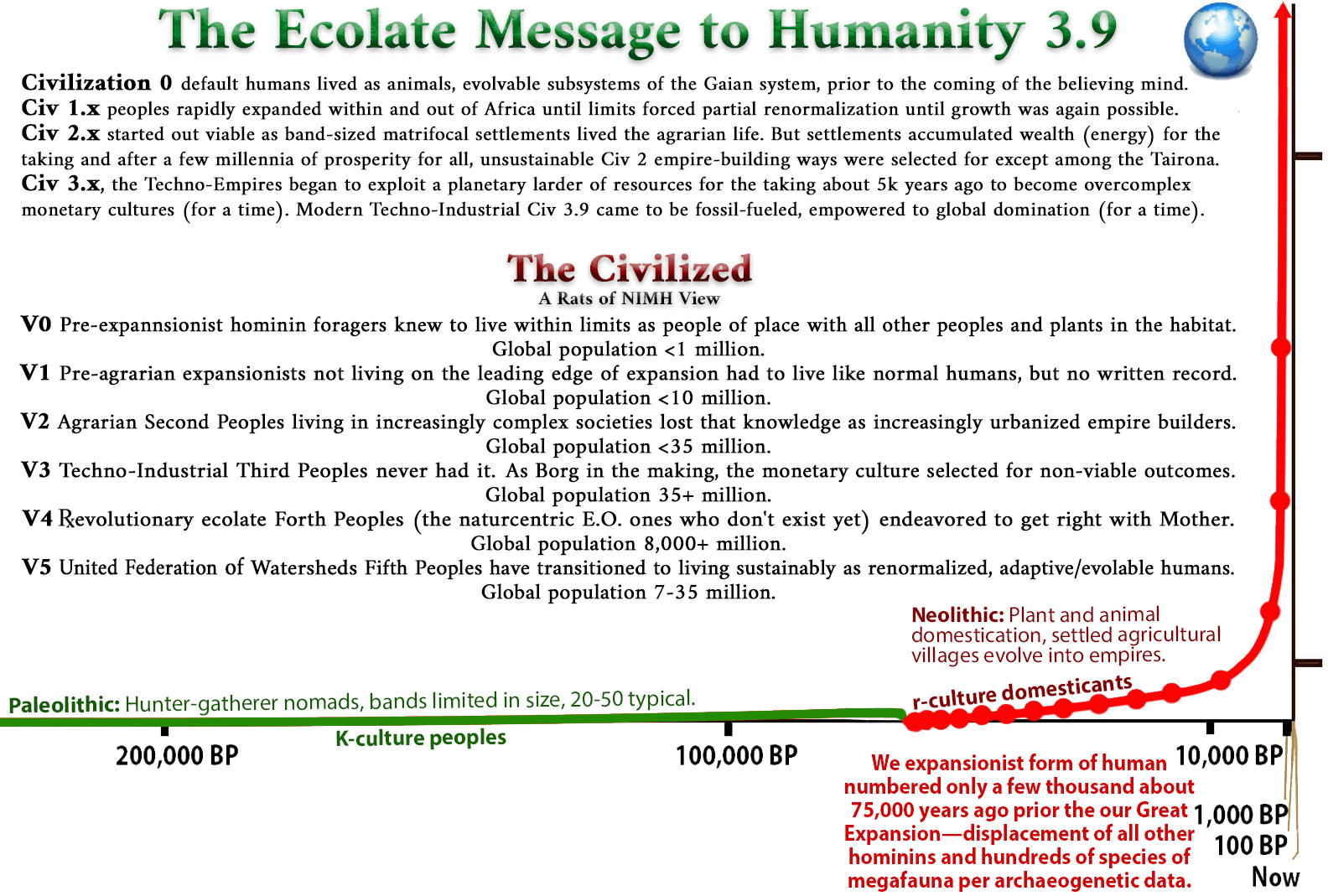
[The early ecolate came to be called the 'E.O. ones', mindless followers of the ecofascist
anti-human E.O. Wilson who advocated for merely a Half Earth for humanity.
The EOs came to accept the term but translated it as 'ecolate ones'.
Civ 4.x would be transitional, likely taking 8-20 generations by following the prime directive:
each generation must objectively become more functional than the last to become Civ 5.0
containing humans who can understand the planet and live with it properly (to persist).
It's been a long way up as it will be down, see full graph.]
[Those living in the generation that in hindsight is viewed as the transition generation will be utterly unaware of transitioning from an endeavor to renormalize as a viable, adaptive, evolvable form of human. Any humans who think they have transitioned will have not as evidenced by delusional storytelling. The beginning of a CIV 5 form of civilization will likely not be apparent until at least 2,500 years of sustainable living have passed as all prior complex societies failed within a range of a decade to three thousand years. The only form of viable civilization to persist to modern times is that of the San (CIV 1.x who were never denormalized as expansionists), as all other indigenous have been assimilated into CIV 2.x or CIV 3.x forms of civilization.]
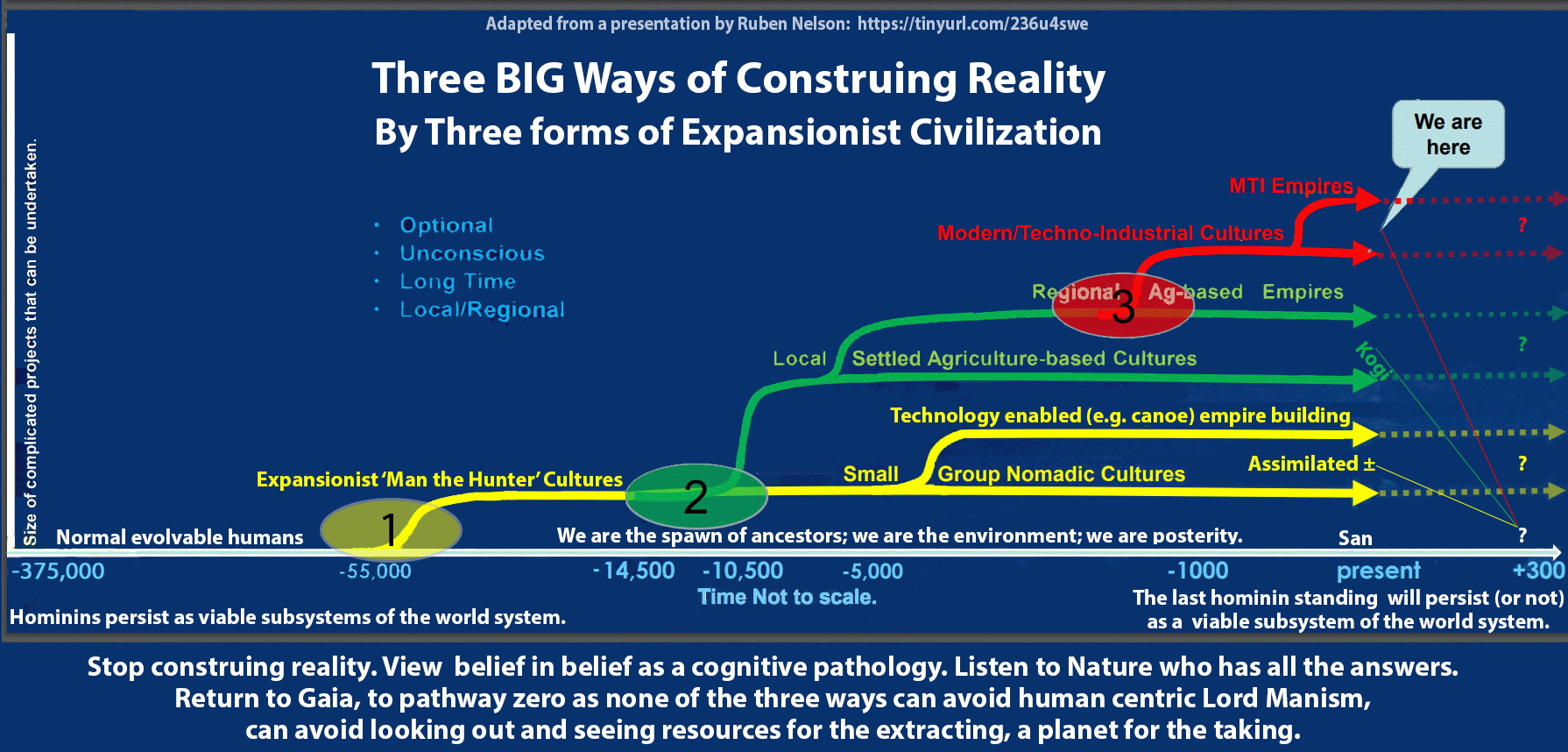
The San are the only real people, the Kogi the only agrarian people proven by their persistence to have renormalized 1100 years ago.
The Tairona phase 1 civilization failed as did the reboot, the phase 2 version, but the phase 3 reboot may have incorporated information about what made the prior two forms non-viable. A remnant population of the Tairona phase 3 culture survived the Spanish genocide of 1650 by retreating to a remote region of the Sierra Nevada de Santa Marta in Northern Colombia. They risk their continued existence in 1990 by inviting a BBC crew to record their Elder Brothers' warning to Younger Brother.
One of three remnant populations of Tairona that survived the genocide in the remote areas of the Sierra Nevada de Santa Marta, aka Heart of the World, has not yet been assimilated, but following their 1990 warning and a second warning message in 2011, demands of tourists to interact with them has become an existential threat, and when the city of Santa Marta and regional economy collapses, there may be enough refugees seeking survival among the Kogi to destroy them as the only known example of a prior expansionist form of human to have renormalized as potentially evolvable K-strategists 1,100 years ago following the collapse of the Tairona phase 2 experiment in complex society.

SUBNOTE TO FILE 1/9/23
It begins: received email with access link to GEDS Ecological Design password protected course. At the top, the first thing I read is 'What an honor to get a visit from you today, Robert'. This could not possibly be true, so decidedly not a good start. I go by my middle name as my father was also a Robert and used PayPal which supplied my first name. Expressions of social approbation for clicking a link are inappropriate, but first impressions can be soon overlooked and perhaps should have been.
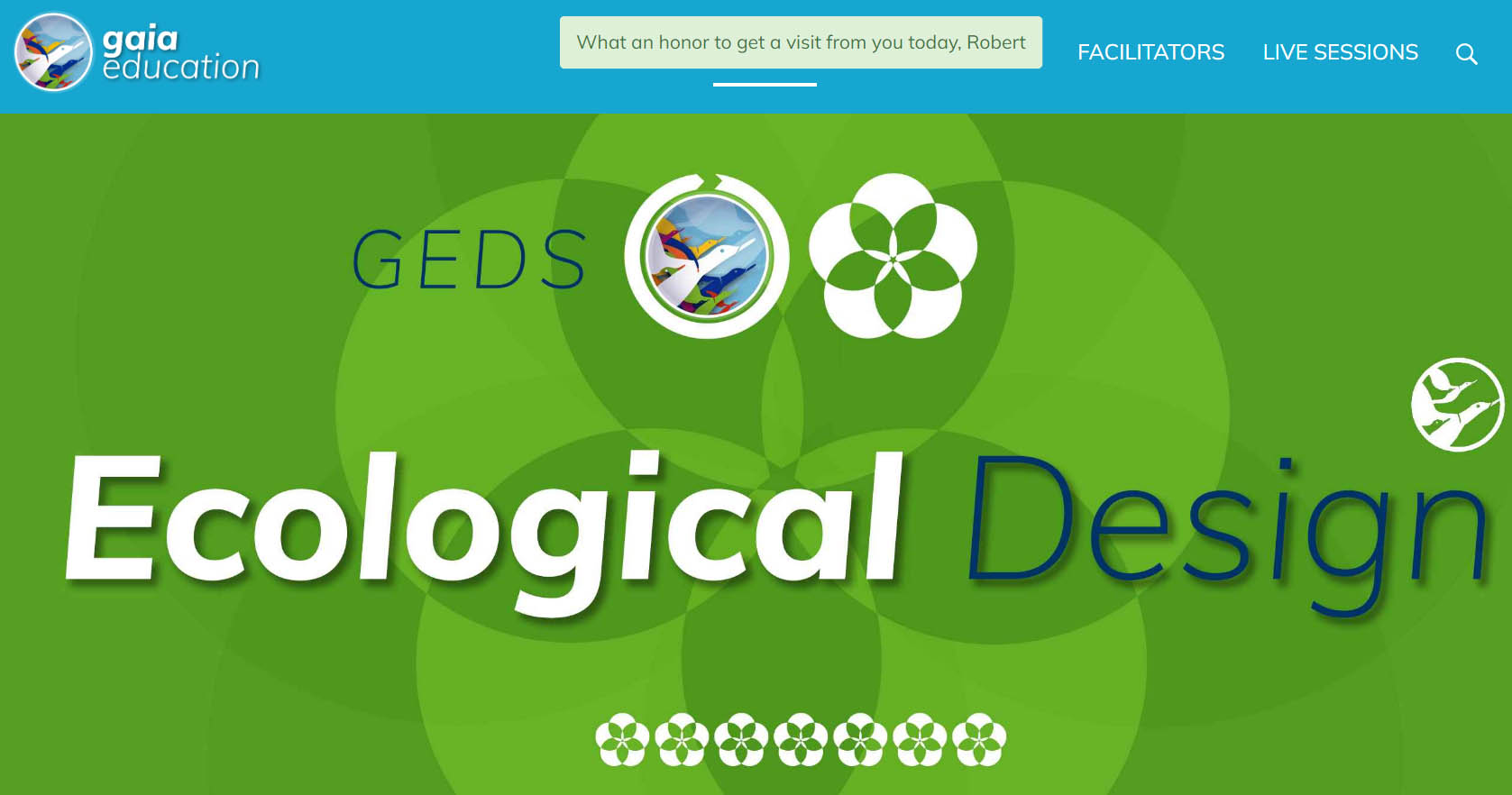
The Gaia Education offering is itself of interest as an example of a non-traditional education offering that may be a best use of the Internet while it is out there. As webmaster for the Union of Concerned Elders, I want to document my initial experience of this form of educational offering. Just below the fold of the above screen is:
Welcome to the Ecological Dimension of the GEDS certificate.
Recommended steps:
- Bookmark this page
- Read Tips to make the best of your journey
- Populate your profile: make sure you have a good picture and share a bit about you and where you are in the world
- Use the introductions forum to say hi and what brought you to this course, share your learning goals and what helps you to learn
- Come back often and check what others have to say
- Attend the live sessions as much as you can as they are a big learning opportunity
- Don't forget your report at the end of the course
- Have fun!
Buttons: Introduce Yourself - Lessons - Forum - Live Sessions
Please finish the Course Modules and submit your Final Report to access the Letter of Acknowledgement.
There is a Buddy List option: 'If you want to buddy up with colleagues or share things outside the course platform, feel free to share your personal information here in this spreadsheet.'
There is then a Gaia Education Team Welcome Video, The video is disabled, clicking anywhere does nothing. I'll guess it will work in a few days.
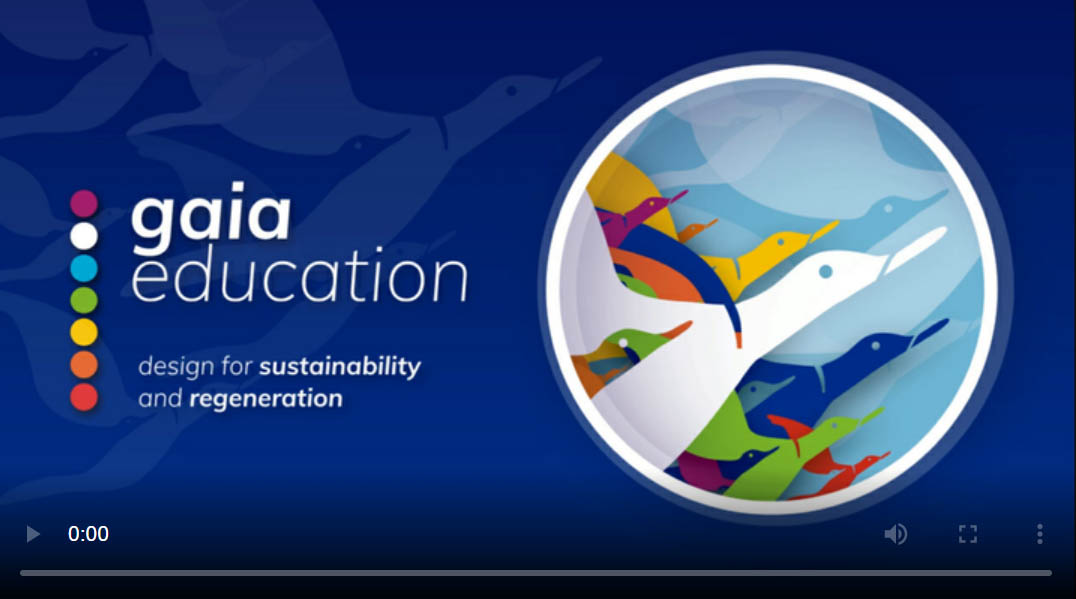
That's all folks. The course site page ends with an ad: Want to make your own course? Try Simplero
This page started with a 'Yo, Robert, what's your biggest intention for today?' It would be rude to answer if doing so were possible (so why ask?).
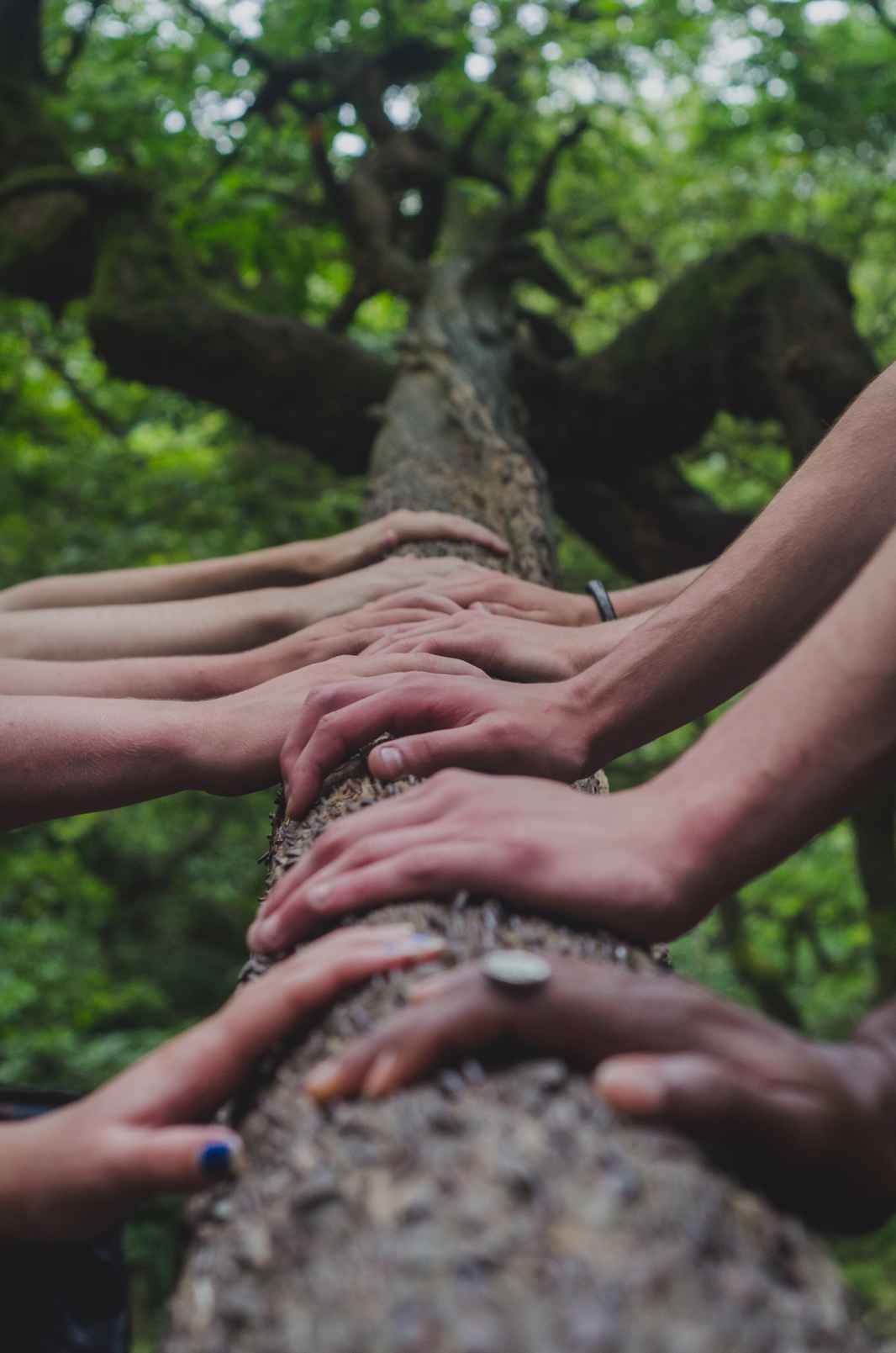
Here are some tips to make the best of your journey with us:
Welcome to the ecological dimension of the GEDS (Gaia Education Design for Sustainability), we are happy to see you all here and inspired to know you want to study with us.
- Start by updating your profile, you will find your profile on the right top corner of the platform: upload a picture, fill out all the fields and write a short profile.
- Familiarize yourself with the course platform: all Gaia Education courses are run in a platform called Simplero, if you have not attended the orientation session, watch the recording so you learn where to find things, who to contact if you are in trouble, etc.
Start NOW
- Start by posting an introduction in the forum for introductions. Even if you have already participated in other GE courses and your profile is updated, an introduction allows all to see you and respond. This will also help you and others to find team mates for the mini project you will need to do for this course, so post about where you live, time zone, interests, etc. to help others to match.
- Plan to spend between 10-15 hours a week, the course has materials to read and links and videos that will allow you to go deeper, we trust you will find the balance of how deep you want to go, this is your learning journey and you are in control.
- Post every week and check what others have posted a couple days later, this will create a good routine and will keep everyone engaged.
- Take breaks and ask for help when needed
- Reach out to your facilitators if you are experiencing challenges and need to slow down or withdraw, please familiarize yourself with the terms (policies) before you make any decision.
- Write to the eLearning assistant or coordinator if you have questions or concerns about anything in the course that cannot be solved by the facilitators: [removed email]
- Stay engaged and support others, attending the live sessions and working together in the projects create real community.
- Enjoy the ride! Remember, if it is not fun, it is not sustainable!
To be present and engaged in this course you will need to:
- Post at least one reflection or resource (with a brief intro) for each forum category or module.
- Create a mini design based on a system of your choice that applies to your life or community (you can choose any system from the ones presented, such as water, energy, food, or retrofitting or you can choose from the systems that are not in the course but are still important, such as transportation or waste). To learn more about the requirements for this mini-design please read ahead.
- Post a brief report about what you learned, what was challenging or surprised you and how you plan to use this new knowledge in your life and community
Posts:
For each module (there are five) you are expected to post at least once. You can choose from:
- Posting about your experience or reflection based on that module "Bring it to Life" suggestion,
- Posting a resource or examples relevant to the module's topic. If you choose this option, you need to add a brief introduction and your thoughts about the resource as well as quote the source of the resource properly.
- Your posts can be in any form: text, video, infographic, picture, etc. Please make sure whatever media you choose to use needs to be understood by your peers and facilitators.
Mini-design:
Your mini design can be done on your own or as part of a team. If you choose to do this as part of a team, teams may not be bigger than three individuals and all their names need to be present in the project. Each member will also need to link to the project when posting their final report.
You can choose any system for your project: water, energy, food, housing, waste, transportation or any other ecologically sound system. You will then choose a challenge. Examples of challenges:
- Your household water system source is municipal. You are concerned about whether this is a resilient and sustainable/regenerative system. You want to improve the resilience of your household by making adjustments to your current water system to make it more regenerative and have redundancy.
- The current sources for the food you consume are not completely regenerative, ethical or resilient. You have learned that some of the food you eat comes from far away and/or affects the ecosystems by the way is grown, transported, distributed or consumed. You want to make sure your food is as much ethical and regenerative and has the lowest ecological impact possible.
- The place where you live is currently not resilient in face of the local impacts of climate change and its built and functioning may be creating more footprint and pollution. You want to make sure the place is as ethical and ecologically sound as possible and that you and your household are protected against the potential impacts of a changing climate.
Once you have chosen your system, you will design a pathway to get to your goal.
What is expected in the mini-design:
- A description of the problem or challenge and some context (location, current challenges, risks and opportunities, climate and other potential factors impacting the system you chose) - Maximum one page
- Context: is this your household, your community? - one paragraph or less
- Who would be the stakeholders if you were to interview them to explore more and test ideas? (example, in your household the stakeholders may be your housemates, your family, your pets and any usual visitor, your neighbours and the community at large) - one paragraph
- A description of your goal/goals in relation to the system of your choice - one short paragraph or bullet-point
- Your design: this may be a graphic/drawing explaining the changes or a paragraph or two explaining the things you would change or implement and how. (no more than one page)
- An analysis of the potential challenges and the expected opportunities you see in this design - one paragraph
- An analysis of how this design applied to this system may affect or interact with other systems (example, what happens to the food when you make changes to the source, use and disposal or water? what happens to the energy? etc. - one paragraph or two
- An analysis of how do you expect the impact or interaction with the other dimensions (social, economic and worldview). Example: what happens with the family economics when you change the source and use of the food you consume? what about their worldview? the social dynamics? - one or two paragraphs.
You can add links to sources, pictures, drawings, tables or videos but keep it simple. This is your practice for the bigger project you will embark in the Design Studio, so have fun!
Final Report
The final report is based on your experience with the course and is independent from the design. You can post your final report in the forum to enrich the experience for everyone. The report is usually short (half a page to a full page) and responds to questions such as:
- What surprised you or challenged you in this course?
- What aspects did you find more useful to your own life or that of your community?
- How do you plan to utilize this information in your life or community?
- What aspects did you miss or would love to see in a future course?
- Anything else you would like to share about your experience with the course topics, content, structure or dynamics
--------------------------
And I read the 8 (so far) introductions and as required introduced myself in kind: I live in the Pacific Northwest bioregion, Pacific Northwest Coast Range ecoregion of North America near Coos Bay. I don't drive, but my wife does and if she says to get in the car I do. I bicycle only if there a time constraint as I prefer to walk. I can walk my kayak on its trailer to the bay and paddle out into the Pacific Ocean or far inland (up to 50 km), going with the tidal flow, of course.
I have had an interest in sustainability issues for 8 years as I have existential concerns for posterity and the biosphere. Prior to today, I have been an autodidact with no formal education that relates to sustainability studies. I am not an expert in any field as time is limited and I am spread thin as a generalist. I do have a focused interest in science, specifically the systems science of H.T. Odum, George Mobus, Charles Hall, and Donella Meadows, though it is also true that I have never met a silo science I didn't like as I have no issues with holism or reductionism as two sides of the same coin.
My interests have focused somewhat in recent years to 'real solutions', as in viable solutions that might actually work to realize James Lovelock's vision that 'eventually we'll have a human on the planet that really does understand it and can live with it properly. That's the source of my optimism.'
For the last two years I've been working on designs for a viable form of civilization. The premise is that the current form of civilization is not remotely sustainable.
SUBNOTE TO FILE 1/10/23
Fortunately I had checked a box to be notified if anyone replied to a forum post. I received an email stating someone, by name, had 'reacted' to my post. My forum post indicates '1 comment' but not who made it as the comment was an icon of a thumbs up only with no indication of source. I imediately checked the other introductions and they also had one or two comments in the form of an icon (none being a down thumb). There are two 'facilitators' whose CV is not provided, but both have a professional level of interest and experteese in permaculture design. Several students indicated interest in permaculture as foundational to any real solutions.
The assigned content is a list of 95 links to lessons with only the first clickable. After reading/viewing the first lesson and indicating completion, the link closes and the second link becomes clickable. Previous content can be revisited. The first lesson is an introduction that adds to the above that:
This course is part of the GEDS: Gaia Education Design for Sustainability and Resilience, a 14-month program that includes four dimensions and a final design studio.
The course is organized into five modules and during the eight weeks of the course you will be learning about:
- Whole systems approach to ecological design,
- appropriate technology: water,
- local food systems
- appropriate technology: energy and
- green building and retrofitting
The material is presented through text and videos and external links to a bibliography, projects and examples. In each module, you may find one or two "bring it to life", which are invitations for you to engage deeper by either reflecting, exploring further or applying some of the concepts and skills you are learning. You are encouraged to engage with these invitations and post about them in the module's reflections forum. We know that learning happens in different ways and one of the most powerful ones happens when you apply. So you are invited to reflect and share or discuss what you are learning with others in the learning community.
I will pay attention to the second lesson, the first presentation of the foundational ideas and sources for the Gaia Education worldview. The sources of the cognitive framework and narratives appear to be the intellectual bedrock all other concepts are built upon. The first offering is quote/paraphrasing 'With acknowledgement to Dr John Todd and Dr David Orr for their paper on Ecological Design Arts'. Several other quotes follow from Wolfgang Sachs, Wuppertal Institute for Climate, Environment and Energy, Germany, Charles Eisenstein, Climate: A New Story, followed by a 3.5 minute video 'Welcome to the Anthropocene' without a transcript provided, but I previously made one with a point by point commentary, so I may post the transcript for consideration without my comments/disputations. The video is a 2016 offering of a special interest group I looked into a couple of years ago and will have to review as I don't recall details.
The next source is Johan Rockström's nine planetary boundaries as they form the outter doughnut boundry of the next concept cluster, Kate Raworth's added intercircle of social boundaries that make for Doughnut Economics. Her views are summarized by her in a four-minute video which I found incomprehensibe since conventional economics with social issues added is not my Wittgensteinian language game any more that John Cobb's process theology is. I will have to make a transcript for consideration/parcing into the avalalange of concepts offered for consideration. If this lesson is foundational, I will have to devote more hours to looking into the claims, and so will start with a copy of lesson two and add comments.
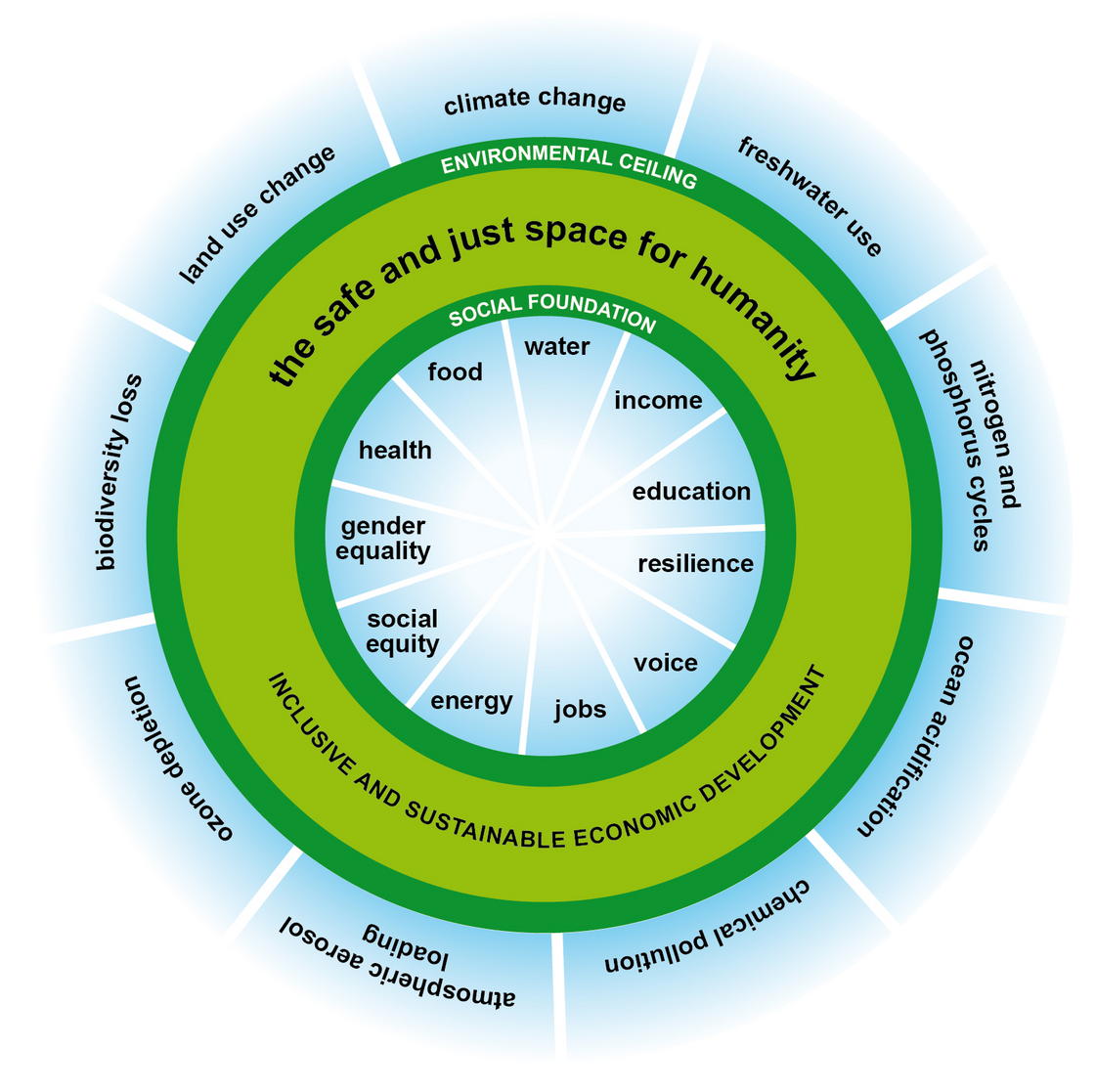
Another graphic:
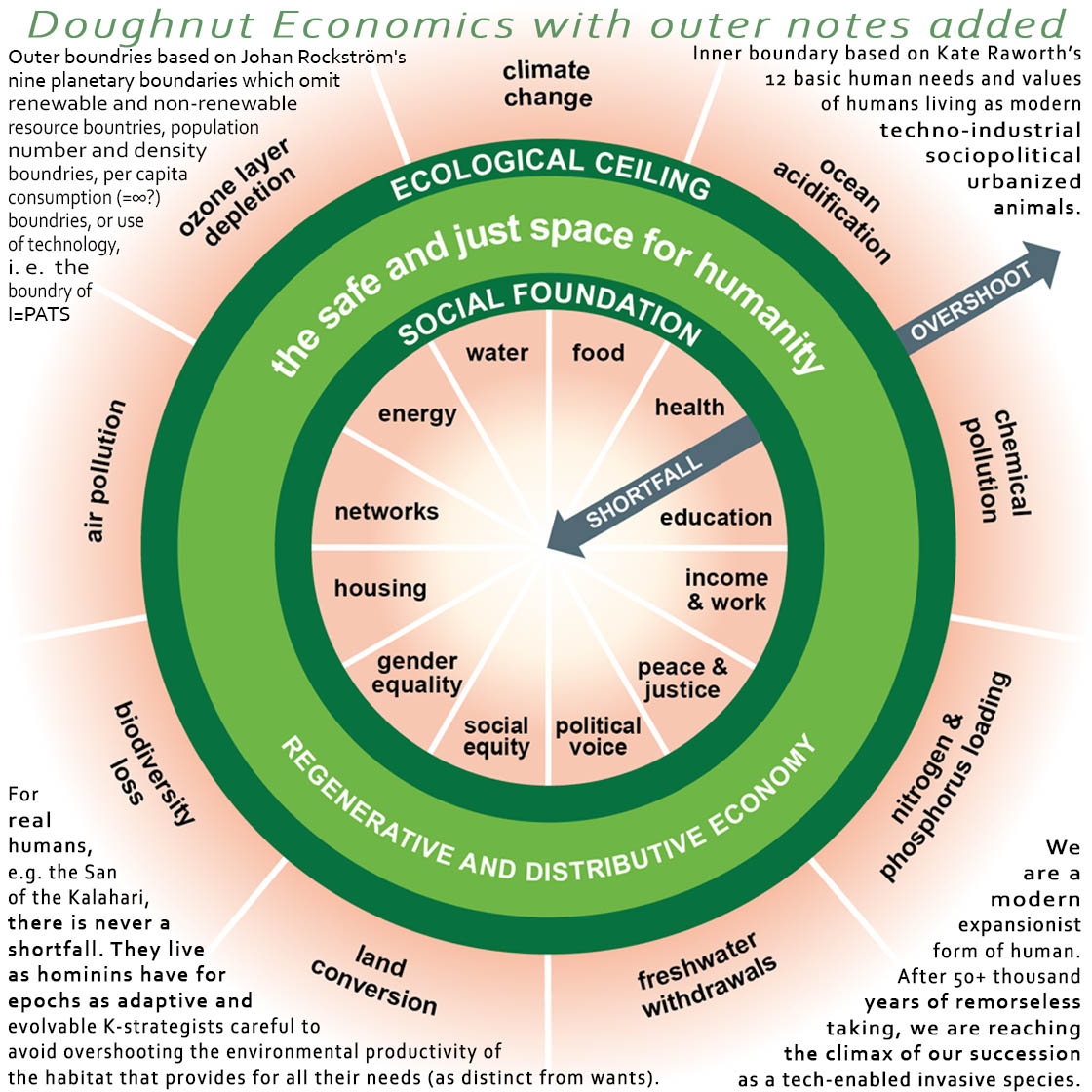
Introduction to Course Content
Final Report
Post-course Comments
